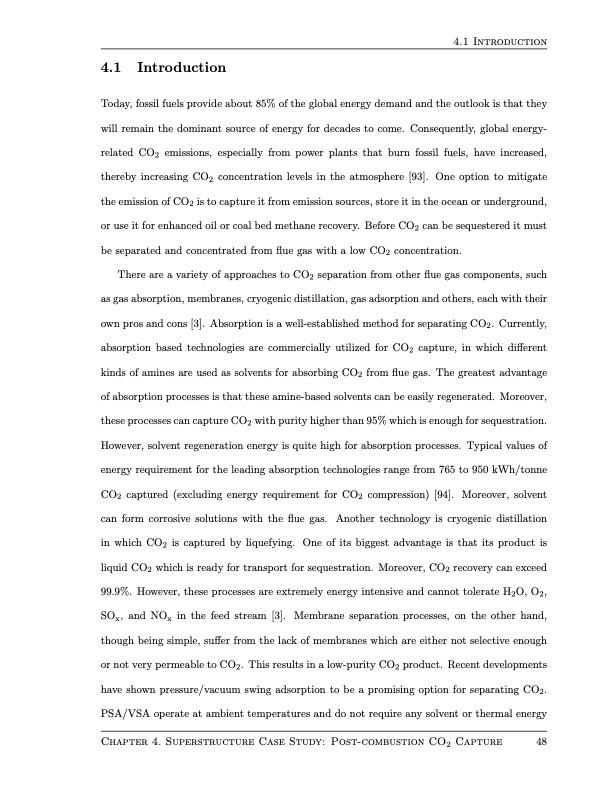
PDF Publication Title:
Text from PDF Page: 062
Today, fossil fuels provide about 85% of the global energy demand and the outlook is that they will remain the dominant source of energy for decades to come. Consequently, global energy- related CO2 emissions, especially from power plants that burn fossil fuels, have increased, thereby increasing CO2 concentration levels in the atmosphere [93]. One option to mitigate the emission of CO2 is to capture it from emission sources, store it in the ocean or underground, or use it for enhanced oil or coal bed methane recovery. Before CO2 can be sequestered it must be separated and concentrated from flue gas with a low CO2 concentration. There are a variety of approaches to CO2 separation from other flue gas components, such as gas absorption, membranes, cryogenic distillation, gas adsorption and others, each with their own pros and cons [3]. Absorption is a well-established method for separating CO2. Currently, absorption based technologies are commercially utilized for CO2 capture, in which different kinds of amines are used as solvents for absorbing CO2 from flue gas. The greatest advantage of absorption processes is that these amine-based solvents can be easily regenerated. Moreover, these processes can capture CO2 with purity higher than 95% which is enough for sequestration. However, solvent regeneration energy is quite high for absorption processes. Typical values of energy requirement for the leading absorption technologies range from 765 to 950 kWh/tonne CO2 captured (excluding energy requirement for CO2 compression) [94]. Moreover, solvent can form corrosive solutions with the flue gas. Another technology is cryogenic distillation in which CO2 is captured by liquefying. One of its biggest advantage is that its product is liquid CO2 which is ready for transport for sequestration. Moreover, CO2 recovery can exceed 99.9%. However, these processes are extremely energy intensive and cannot tolerate H2O, O2, SOx, and NOx in the feed stream [3]. Membrane separation processes, on the other hand, though being simple, suffer from the lack of membranes which are either not selective enough or not very permeable to CO2. This results in a low-purity CO2 product. Recent developments have shown pressure/vacuum swing adsorption to be a promising option for separating CO2. PSA/VSA operate at ambient temperatures and do not require any solvent or thermal energy 4.1 Introduction 4.1 Introduction Chapter 4. Superstructure Case Study: Post-combustion CO2 Capture 48PDF Image | Design and Operation of Pressure Swing Adsorption Processes

PDF Search Title:
Design and Operation of Pressure Swing Adsorption ProcessesOriginal File Name Searched:
anshul_thesis.pdfDIY PDF Search: Google It | Yahoo | Bing
CO2 Organic Rankine Cycle Experimenter Platform The supercritical CO2 phase change system is both a heat pump and organic rankine cycle which can be used for those purposes and as a supercritical extractor for advanced subcritical and supercritical extraction technology. Uses include producing nanoparticles, precious metal CO2 extraction, lithium battery recycling, and other applications... More Info
Heat Pumps CO2 ORC Heat Pump System Platform More Info
| CONTACT TEL: 608-238-6001 Email: greg@infinityturbine.com | RSS | AMP |